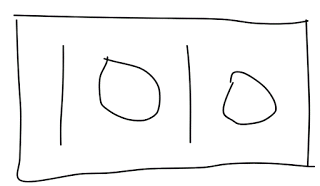What are Golang Types
Go is a strongly typed language and type is life. This language has rich types and good support for extension of type. Type provides integrity.
In this post I will share some of the primitive types and how Go handles them.
Everything is 0 or 1 in computer and only these 2 values are used to represent any values we want.
Arrangement of 0 or 1 tells what is the value.
Take a example of byte value at some memory location:

What is it ? You need type information .
If type is int then value is 10, if type is enum then we have some other value.
Type information tell us about value and size for eg if type is Boolean then it tells it is single byte value.
Information about types supported by Go can be found at Lang Spec Types page.
How to declare variable ?
1 | var variablename type<br><br>variablename := value // Short declaration |
Both of the above declare a variable but the way it is initialized is very different.
Var creates and initialized with ZERO value of its type, Zero value is very special it makes code bug free and clean! No null checks.
Zero value is based on Type so for integer type it is zero, boolean it is false , string it is empty.
Go has some type like int that gets size based on underlying architecture, for eg it will be 4 bytes (i.e 32 bit arch) or 8 bytes ( 64 bit arc). This is also a good example of mechanical sympathy to underlying platform.
Examples of variable declaration:
01 02 03 04 05 06 07 08 09 10 11 12 13 14 15 16 17 18 19 20 21 22 23 24 25 26 27 28 29 | var value int var f float64 var b bool var by byte var name string var x rune //Variable are declared and initialized by compiler to ZERO VALUE of its type fmt.Printf("value %T -> (%v) \n", value, value) fmt.Printf("f %T -> (%v) \n", f, f) fmt.Printf("b %T -> (%v) \n", b, b) fmt.Printf("by %T -> (%v) \n", by, by) fmt.Printf("name %T -> (%v) \n", name, name) fmt.Printf("x %T -> (%v) \n", x, x) fmt.Println("*******************") value1 := 10 f1 := 3.14 b1 := true name1 := "Say Hello" x1 := 100 fmt.Printf("value %T -> (%v) \n", value1, value1) fmt.Printf("f %T -> (%v) \n", f1, f1) fmt.Printf("b %T -> (%v) \n", b1, b1) fmt.Printf("name %T -> (%v) \n", name1, name1) fmt.Printf("x %T -> (%v) \n", x1, x1) |
Alias for built in type
This is a very powerful feature and it allow to built in types to be extended by adding behavior .
Example of type alias:
01 02 03 04 05 06 07 08 09 10 11 12 13 | //Create Alias for int typetype RichInt intfunc main() { var ri RichInt ri = 100 fmt.Println("Value of rich int", ri) fmt.Println("Convert to Int", int(ri)) fmt.Println("From int to Rich Int", RichInt(100)) fmt.Println("Binary Value", ri.toBinary())} |
In the above example RichInt has toBinary function that returns binary value. I will share later how to extend types when we explore methods of types.
Casting Vs Conversion
Casting is magic, it allows to convert one type to another implicitly. How many times in java you lost a value when long/int casting or double/float?
Go has a concept of conversion. You explicitly convert from x to y type and pay the cost of extra memory at the cost of safety.
Go lang spec has some good examples.
Some real custom types
Go lang has support for Struct type, it is pure value type , no noise of behavior attached to it.
It gives control of memory layout, you can choose really compact memory layout to avoid padding or to add padding if required.
Struct can be declared like below:
1 2 3 4 5 | type person struct { firstName string lastName string age int} |
Once struct is defined then we can create value of struct type.
It is value not object just remember that!
Value can be created using the below code:
1 | var p1 person |
The above code created a value and initialized it with zero value, string is initialized to empty value and int to 0.
No null check is required when processing p1 because it is initialized to ZERO value.
Short declaration can be used to specified non zero or other value:
1 | p2 := person{firstName: "James", lastName: "Bond", age: 35} |
Zero value and convenient way to creating value kills the need of having constructor or destructor in Go.
You can now start seeing power of value. No overhead of constructor/destructor/ or complex life cycle.
I know you will have question on what about special init code or clean up code that is required ?
Behavior are handled very differently, we will go over that in a later post.
Struct can be nested also and Zero value or short declaration works like magic!
We will create additional struct:
01 02 03 04 05 06 07 08 09 10 11 12 13 14 15 16 17 18 19 20 21 22 | ype address struct { address1 string address2 string city string}type contact struct { landLine int mobile int}type person struct { firstName string lastName string age int add address contactDetails contact}p3 := person{firstName: "James", lastName: "Bond", age: 35, add: address{address1: "30 Wellington Square", address2: "Street 81"}, contactDetails: contact{mobile: 11119999}} |
Published on Java Code Geeks with permission by Ashkrit Sharma, partner at our JCG program. See the original article here: what are Golang Types Opinions expressed by Java Code Geeks contributors are their own. |



